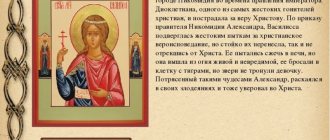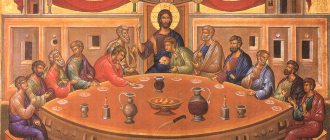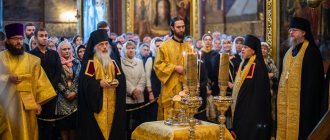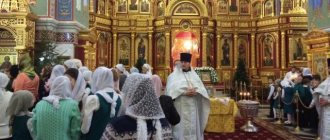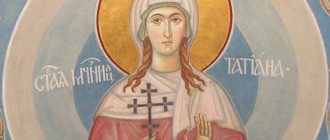Why does Maslenitsa start at different times?
Because, according to the church, this is the last week before the beginning of Great Lent , preparing Christians for Easter. And this holiday is one of the so-called “transitional” holidays. This means that it falls on different days of the year due to the peculiarities of calculating the date, which depends on the lunar calendar. The date of Easter determines the start time of Lent, and the week in which Maslenitsa falls in a particular year depends on it.
Moving dates of the Orthodox calendar for 2022. They depend on the day of Easter celebration.
From the history
In pre-Christian times, the celebration of Maslenitsa was timed to coincide with the spring equinox.
Maslenitsa is an East Slavic traditional holiday celebrated during the week before Lent, which retained a number of elements of Slavic mythology in its ritual.
In pre-Christian times, the celebration of Maslenitsa was timed to coincide with the spring equinox, which for a number of peoples using the solar calendar is the beginning of the new year.
Therefore, now in the minds of many there is confusion, a mixture in Maslenitsa of both the pagan roots of the holiday and its true Christian meaning. A true Orthodox believer must be able to distinguish between them and not succumb to public provocations.
There is no reason to claim that Maslenitsa is its own pagan holiday. Maslenitsa ritual rethinks what the Church offers. In particular, fasting in traditional culture is understood primarily as food restrictions; accordingly, before starting fasting, you need to eat as much as possible. But this is already gluttony, and this should be understood by all Orthodox Christians who celebrate Maslenitsa. The main tradition that reflects the “pagan” essence of Maslenitsa is the making and burning of effigy. Therefore, you should definitely not participate in such a ritual event.
Pagan holiday or Orthodox?
The church calendar does not contain “Maslenitsa” as such, and the Church has never considered this celebration “its own.” Essentially, there is a coincidence:
- the traditional pagan holiday for the Slavs (as well as for many other peoples) of welcoming spring, the beginning of a new life for nature, and also, at the same time, commemorating ancestors;
- preparations for Great Lent, when special services are already taking place in churches preparing believers for the “Holy Pentecostal Day”, weddings are not taking place, a gradual restriction of one’s diet begins, so that the transition to fasting abstinence is not abrupt.
The rite of forgiveness in the temple on the eve of Lent
Is this a coincidence? Of course no.
Let's talk about Maslenitsa
Boris Kustodiev. Maslenitsa
Nowadays, oilseed celebrations are taking place everywhere.
On the one hand, this is a holiday of the coming spring, a good time to go on a visit, meet with friends and family, have fun... True, this holiday sometimes leads to gastronomic excesses, often acquires elements of pagan revelry, and for some it gives an excuse to simply get really drunk .
On the other hand, Maslenitsa is a preparatory week for Lent, and even the semi-fast days themselves, when meat products are excluded from the diet, when the Divine Liturgy is not celebrated on Wednesday and Friday and the repentant prayer of St. Ephraim the Syrian.
We asked the shepherds to express their opinion about Maslenitsa, to answer the question: how should we relate to this paradox, this antinomy of the holiday and the beginning of fasting? How can a Christian spend these days correctly?
***
Archimandrite Tikhon (Shevkunov),
abbot of the Moscow Sretensky Monastery:
– For me, Maslenitsa has always been perceived as a long-awaited and very joyful time. And the fact that people meet these days and have feasts - I don’t see any particular trouble or sin in this.
Feast, pancakes - this is also not without reason! The meaning of Maslenitsa, of course, is not riotous festivities and riots. This is obvious, and for a Christian it requires neither explanation nor boring denunciations. The special meaning of Maslenitsa in very recent times, when there were no telephones or e-mail, was so that people, during the week preceding Forgiveness Sunday and Lent, had time to go and visit their close and distant friends and relatives, to ask each other's forgiveness. And having reconciled, having asked for forgiveness, how can one not sit down to a feast? After all, quite recently everyone heard in the church the Gospel reading about Zacchaeus, who, having repented, with all his heart, arranged a treat for the Savior and for his friends. Or the parable of the prodigal son, about the happiness of reconciliation and forgiveness: “... bring the fatted calf and kill it; Let's eat and have fun! For this son of mine was dead and is alive again, he was lost and is found. And they began to have fun” (Luke 15:23). Only instead of calf during Meat Week we have pancakes.
All this is so vivid, understandable to every person, so natural that, frankly, it is always a little surprising to see excessive moralizing about Maslenitsa these days.
I am sure that for the majority of Orthodox Christians this entire coming week, which will include Lenten services on Wednesday and Friday, and friendly communication, and forgiveness of offenses, and hospitable feasts, will all reveal a special, unique and joyful holiday of anticipation , preparation for Lent. Hegumen Peter (Eremeev)
(rector of the Russian Orthodox University; rector of the Church of St. John the Theologian - Patriarchal Metochion in Kitai-Gorod):
– The church celebration of Maslenitsa has enormous missionary and educational potential.
80 years of militant materialism in our country hit both Orthodox spirituality and folk culture at once, despite all the conventionality of this division. And if in pre-revolutionary times we really observed how individual church holidays in everyday life were intertwined with sometimes wild folk traditions that had connections with the pagan past of the Slavic tribes, now there is no need to talk about this. Of course, the bad thing is that our compatriots have practically erased their historical memory and completely lost their tradition. But this is precisely what allows us today to churchize folk traditions and customs reconstructed almost from scratch, using the enormous cultural potential of Orthodoxy.
Maslenitsa is a wonderful week. Each Christian must decide for himself how much he can participate in Maslenitsa entertainments, how relevant they are at the moment for his spiritual life. Communicating with relatives and friends at the holiday table will not harm anyone: there is an opportunity to meet, try to understand another, reconcile with someone, in order to enter into fasting with a clear soul and a clear conscience. Maslenitsa provides parents with a wonderful opportunity to give their children the joy of the holiday. A holiday on the street is generally a great opportunity to get out of your apartments, finally meet your neighbors, and feel like a member of a large human family.
I am convinced that now we, priests, must do everything to ensure that the center of the celebration of Maslenitsa becomes the temple, the cathedral square. This is already happening in many cities today. Several years ago I was struck by the experience of the Birobidzhan diocese, which headed the preparation and holding of Maslenitsa in the cathedral city and coped with this role brilliantly. Today, by and large, there is no one except the Church to organize a national holiday so that it turns out not vulgar, not primitive.
If we do not do this, if the Church, represented by the clergy and active laity, does not begin to deal with the topic of folk customs and traditions, then some neo-pagans or other empty-headed preachers will do this.
We live in an era of incredible opportunity and great responsibility. Today we can make the celebration of Maslenitsa truly Christian or, conversely, completely lose the opportunity to do this. Hieromonk Macarius (Markish)
(Ivanovo-Voznesensk diocese; teacher at Ivanovo-Voznesensk Theological Seminary):
– We need to look at Maslenitsa from a broader perspective – and then everything falls into place.
Yes, of course, a colossal amount of all sorts of abuses, stupidity, outright madness, wickedness and unbelief... But are these specific features of Maslenitsa?
No, these are simply the properties of the current para-church, pseudo-church, superstitious and meaningless life (however, not only the current one!). The properties are very bad. But the breeze of optimism brings hope: the more often people hear about Maslenitsa and related items, the more and more likely they will pay attention to the future. If they pay attention, they will think. Thinking about it, they will understand or feel something. And they will get down to business... Hieromonk Simeon (Tomachinsky)
(resident of the Moscow Sretensky Monastery, head of the publishing house of the Sretensky Monastery):
– Unfortunately, with all the abundance of civil and church “red days of the calendar”, we often do not know how to celebrate or have fun. This is an entire art that is worth learning. But, for example, a person who does not fast will never understand and appreciate such events as beginning and breaking the fast - not only in a gastronomic sense, but generally as a state of mind. After all, it is fasting that gives the holidays associated with it a special value and a unique aroma...
One famous Moscow priest once said that during Maslenitsa you should eat so many pancakes that later the very sight of a pancake would cause disgust. This is probably something like “mortification of the flesh,” about which much has been written in ascetic literature.
But this is also a good reason to visit relatives or friends with whom in the hustle and bustle of ordinary life it is not possible to sit and talk calmly. This is also the last warm-up before the Lenten marathon. An opportunity to gather your thoughts, your strength, your spirit.
“Pokurguzka, lyuli, pokurguzka” - this is how folk songs mourn the shortness of Maslenitsa days, after which “it will become thick,” that is, sad.
However, in fact, it’s great that “not everything is Maslenitsa for the cat.” Because “a time for every thing under the sun... a time to weep and a time to laugh; a time to mourn and a time to dance” (Eccl. 3:1-4). Archpriest Dimitry Moiseev
(candidate of theology, teacher at Kaluga Theological Seminary):
– In fact, this is not a paradox. The fact is that for a Christian, liturgical life is the main element of preparation for Lent. Accordingly, an Orthodox Christian, of course, must attend services on these days. Moreover, they are of a special nature. At the same time, before Great Lent, a Christian is given relaxation regarding food, that is, consolation at the meal. At the same time, Maslenitsa is not a reason to overeat to the limit, so that you don’t want to eat until Easter. It still won't work. The meal charter for Maslenitsa is a consolation for those who pray, attend services and seriously prepare for Lent.
Burning a Maslenitsa effigy and climbing a pole are purely pagan relics. It is better for an Orthodox person not to go to these folk festivals. They have nothing to do with Christianity.
Another question is that not everyone is able to immediately switch completely to a Christian way of life. And if such a person is going to fast during Great Lent, that is, to pay more serious attention to his soul, then, of course, you can show him leniency and not scold him for celebrating Maslenitsa.
Again, the celebration should be reasonable: one should spend time not in drunkenness, not in overeating, but in some fairly harmless entertainment and amusement, because during Lent all this will be generally unacceptable. I think that as each Christian grows spiritually, he will gradually abandon such purely worldly, secular amusements at Maslenitsa and increasingly understand the spiritual meaning of this preparatory week. After all, Cheese Week (Maslenitsa) takes place between the weeks (Sundays) of the Last Judgment and the remembrance of Adam’s exile. That is, the two Sundays that frame Maslenitsa tell us about rather serious events in the history of mankind, which are not particularly conducive to fun.
Here it is impossible to approach each person with one standard, but the vector of movement must be clear. We need to strive to ensure that entertainment takes up less and less of a person’s attention, and that worship and a serious attitude towards prayer and fasting occupy more and more.
On Cheese Week, of course, you can hold cultural events, creative evenings of Orthodox content, if we are talking about getting away from crude entertainment and amusements and gradually coming to the spiritual through the spiritual.
Archpriest Artemy Vladimirov
Archpriest Artemy Vladimirov
(rector of the Moscow Church in honor of All Saints of the former Alekseevsky Monastery in Krasnoye Selo):
Maslenitsa, or Cheese Week, is the last week before Lent. In preparation for it, Christians no longer eat meat at Shrovetide, but eat dairy (including on Wednesday and Friday).
Many find it difficult to combine the cheerful, hospitable feasts of Maslenitsa with the thought of the Last Judgment of the Lord that permeates the church services of these days. Others see the Russian tradition of baking pancakes as almost rudiments of pagan self-awareness. We hasten to dispel this imaginary contradiction. The fact is that you need to prepare for a meeting with the Lover of Mankind, Christ, by performing six works of gospel mercy: giving a drink to the thirsty, feeding the hungry, bringing a stranger into the house, clothing the naked, visiting the sick and visiting the one languishing in prison.
Maslenitsa, with its Russian hospitality, gives us the opportunity to work in active charity.
A common meal has the ability to soften and reconcile hearts. But it is no coincidence that the last Sunday before Lent is called Forgiveness! Let us prepare for it by mutually forgiving and consoling all near and far for the glory of God! Archpriest Dimitry Mertsev
(chairman of the jury of the Kuban Orthodox Film Festival “Veche Bell”):
– Despite the fact that in our time Maslenitsa is more of an ethnography, a folk tradition that does not have pagan ritual significance, nevertheless it has nothing to do with Christianity.
It is necessary to spend Maslenitsa (or, more accurately, Cheese, or meat-eating) week in the dynamic mood of repentance, and this dynamic is precisely given by the church charter. The Church is already preparing us ahead of time for Lent with the Gospel parables about the publican and the Pharisee, about the prodigal son and, finally, a reminder of the Last Judgment. And although during the week we still taste the humble meal about the publican and the Pharisee, the Church is already reminding us that we must tune in to such a prayer as the publican’s in order for it to be accepted by God. In this sense, Maslenitsa does not exclude moderate fun, and at the same time it is already illuminated by the approach of Lent. During this period, Orthodox Christians can, for example, spend a literary and musical evening: read poetry with Christian content, listen to spiritual chants with a mood of repentance (for example, the ballad about Kudeyar - about the twelve thieves). This kind of entertainment before Lent is quite appropriate.
The attitude of non-church people towards this holiday is known: “Soon a merry feast will boil with the bell of Maslenitsa...” However, it is unacceptable for believers on Maslenitsa to participate in general revelry, overeating and drunkenness. Saint Tikhon of Zadonsk said: “Shame covers my face when I talk about how Orthodox Christians celebrate Maslenitsa.”
In this week, the last before Great Lent, it would be good to remember the advice of St. Sergius of Radonezh: “Keep abstinence.” The beginning of fasting is unthinkable without the physical preparation that the Orthodox Church offers us. Monday of the 1st week of Lent is called Clean Monday: a clear conscience, a pure soul - because it was Forgiveness Sunday. You also need to be clean in body, if a person is God’s, therefore there must be abstinence. According to the words of the holy fathers, Lent is the spring of the spirit, because when we limit ourselves physically, our spirit blossoms. Those who have tasted this joy of Lent already treasure these days and look forward to them. Only an intemperate soul, a person who pleases his flesh, perceives fasting as something painful. When a person adheres to the church rules, is imbued with the spirit of worship, and prepares himself for entering the Pentecostal period, then those restrictions that are associated with the Lenten period are perceived organically by him.
The Church, in relation to its children, has a maternal character. This is both tenderness and severity of pedagogy to bring us to Christ. The Church always gives us gradualism in everything. While the gradual introduction into the forms of repentance through church services has already begun (“Open the doors of repentance for me...”, the prayer of St. Ephraim the Syrian “Lord and Master of my life...”), the opportunity is still given to strengthen oneself with modest food, and only then comes Great Lent.
There are people who have the skill of fasting: it is easy for them, they enter into Lent with joy. And there are those who are just beginning to become churchgoers: it is difficult for them, and the Church leads them very kindly and tenderly. As St. Seraphim of Sarov said, “a person cannot embark on a feat until he purifies his feelings,” therefore, we should not perceive Lent as only restrictions and prohibitions. This, on the one hand, is asceticism, which limits our physicality, and on the other, the special nature of worship, which elevates the soul. And one complements the other.
This is how a loving mother acts towards her child: she caresses and scolds, gives some visible task and makes sure that the child obeys.
The Church leads us in the same way. I think that the antinomy that exists and is clearly expressed on Maslenitsa days is explained by this character. Priest Alexy Zaitsev
(cleric of the Holy Trinity Church in Chelyabinsk, member of the Union of Writers of Russia, member of the International Club of Orthodox Writers “Omilia”):
– The history of Maslenitsa celebrations in the life of the Russian people goes back several centuries. Speaking about Maslenitsa (more precisely, Cheese Week), we must remember: initially there were two fundamentally different traditions of spending this special time of year, which can be conditionally designated as follows: “purely church” and “purely secular”.
Those who followed church tradition perceived the last week before Lent as the most important stage of preparation for it. Believers understood: if these days were spent in excessive pleasures and amusements, Lent would be disrupted for them. In the bosom of the Holy Church, the liturgical practice of preparing for Cheese Week in prayer and repentance has developed.
We remember from Russian history that Lenten days left an imprint on the way of life of all citizens of the Russian state, including those people who did not have a deep religious feeling and did not even belong to Orthodoxy at all. Therefore, secular tradition saw Maslenitsa as those days when one could let off the “last steam” and have plenty of fun before the onset of Lent. It was this tradition that formed the basis of Maslenitsa festivities in pre-revolutionary Russia with their fist fights (where they could kill for fun), drunkenness, gluttony and debauchery. The church and state authorities tried to resist the riotous component of the pre-Lenten days, but this was not always successful. With the impoverishment of faith among the Russian people, Maslenitsa festivities acquired an increasingly immoral character and elements of paganism began to appear more and more clearly in them. If a person does not need Lent, then in Maslenitsa he will seek joy only for the flesh.
It is worth noting that for every Christian, Maslenitsa is the time when one should settle one’s worldly affairs, hold the necessary social meetings in order to devote the days of Lent exclusively to caring for the healing of one’s soul.
I repeat, it is wiser to solve your worldly problems before the beginning of Lent, rather than address them in its very first and most important days. However, I am sure: a true Orthodox Christian will find spiritual strength and wisdom in himself so as not to get carried away by excessively worldly concerns and not deprive himself of the invaluable time of Lent for spiritual growth. Priest Pavel Gumerov:
– For many pagan peoples, the transition from winter to spring was accompanied by certain religious rituals and celebrations. This was the case in Rus'. The transition from hibernation to spring rebirth was marked by a holiday called Komoeditsa or Maslenitsa.
The Church did not always completely abolish folk pagan traditions and holidays, realizing that simply prohibitive measures were ineffective, but often replaced pagan holidays with Christian ones and, as it were, churched folk customs, giving them a completely different meaning. So it was with radonitsa, and with the custom of caroling, and with the same Maslenitsa. The Church timed Maslenitsa to coincide with the Cheese preparatory week before Lent, removing the pagan meaning and replacing it with new Christian content.
For Orthodox Christians, Cheese Week, Maslenitsa, is a week of smooth transition to fasting. And even a meal, already devoid of meat foods, reminds us of this. It is dedicated to the memory of the Last Judgment. On Tuesday of this week, during the evening service in churches, the prayer of St. Ephraim the Syrian is already read, “Lord and Master of my life...”, and, of course, revelry and drunken fun are absolutely incompatible with the meaning that the Church puts into this preparatory week. We, of course, do not deny reasonable, moderate fun at Maslenitsa. We go to visit each other, eat pancakes and save up strength before fasting.
But, unfortunately, we have to observe that not everyone observes the measure, and many spend Cheese Week in a completely pagan way. I am not talking about those people who do not fast - for them there is no concept of preparation for fasting. They can burn a Maslenitsa effigy, and then go to the Easter religious procession with the same interest. Both are good, in their opinion. No, I mean Orthodox church people who sometimes do not think about the fact that riotous fun, gluttony and drunkenness are unacceptable on Shrovetide week (all these “bad excesses” are unacceptable, however, on any other days of the year). Unfortunately, this formula is very typical for us: either everything or nothing. And, by the way, not only in modern de-churched Russia, but this was also the case before the revolution. Not everyone knew the limits and held back in the Maslenitsa revelry. As Dostoevsky said, “Russian people are broad, I would narrow them down.” One can also recall another character of Fyodor Mikhailovich - Mitya Karamazov, about whom it was said that he could contemplate, as it were, two abysses: vice and virtue.
Saint Tikhon of Zadonsk said: “Whoever spends Maslenitsa in excesses becomes a clear disobedient to the Church and shows himself unworthy of the very name of a Christian.”
Fasting is a school of abstinence and moderation in everything. During Lent and other fasts, we must learn to subordinate the aspirations of our flesh to the spirit, to control our desires and desires, so that, having mastered this science, we can observe reasonable moderation and abstinence from sin in everyday life. And if after fasting we give ourselves complete freedom, let go of the reins - break our fast without measure, and then also start fasting immoderately before a new fast, then we have not learned anything during fasting.
I remember one of my acquaintances who fasted very diligently, ate almost nothing during the first and Holy Weeks of Great Lent, but then after Easter he could go on a binge. And again it turns out that we are not the masters of our instincts and aspirations, but they subjugate us to themselves.
God grant that the coming fast will teach us at least a little about abstinence and serve spiritual and physical benefits.
Archpriest Andrey Tkachev
(rector of the Church of St. Agapit of Pechersk in Kiev):
- Man is a fallen creature. If he wants to invade, to break into the spiritual world, then these “beautiful impulses of the soul” will initially lead not to pure spirituality, but to a world of substitutions and inversions, to counterfeits of holiness, to a world of tinted lies.
This idea runs like a red thread through all the works of St. Ignatius (Brianchaninov). He bequeathed it, as one of the real treasures, to the coming centuries with their increasing poverty and multiplying illusions.
Paganism never died “to the end.” In a world where flesh and spirit are opposed to each other, where the flesh has not yet been transformed, it is warm and cozy for paganism to hide in that part of life where the flesh is the undivided mistress. Neither poverty, nor wealth, nor the rudeness of life, nor the subtleties of enlightenment are an obstacle to paganism. A person with two higher educations is just as capable of running to his “grandmother” for magical help as a poorly educated peasant. The twilight, magical consciousness is capable of interpreting and reinterpreting everything to suit itself, capable of adding its own fly in the ointment to any amount of honey, destroying the value of the latter.
This, it seems to me, also applies to Maslenitsa. There was no shame in celebrating it in the sense of saying goodbye to winter and welcoming the long-awaited warmth of spring even during the years of state-atheistic ideology. There we were not talking about preparing for Lent and gradually giving up fast food. The meaning of the Gospel readings about the prodigal son, the Last Judgment and Adam's exile was not explained to the walking masses. Instead, hot pancakes and vodka, especially tasty in the cold, the burning of an effigy, the sounds of an accordion, sliding down slides, women’s squeals, skates, the bells of the distant troika were presented as “ours”, “native”... - in a word, everything that goes into the concept of “a la russe” and Mikhalkov’s style of “The Barber of Siberia”. Yes, that’s okay.
There is a place and time in life for healthy laughter, jokes and delicious food. Just call it by its proper name, and not “spiritual revival” or “return of traditions.”
Here paganism does not sleep, but shows marvelous agility in the era of information technology. It offers everyone its vision of the meaning of Maslenitsa with the symbolism of the increasing day, pancakes shaped like the sun, etc.
The Church spent centuries on the churching of the pagan calendar and folk rituals. To the end, as has already been said, paganism never died. Now it will be ready at any moment, having decorated its head, depending on the season, with either a mermaid’s wreath or a buffoon’s hat, to appear at a folk festival and offer its own version of understanding the world. Reflecting pagan attacks on the historical Church will now be one of, if not the most difficult, then the most constant occupations of church apologists.
So there is no need to be smart about Maslenitsa.
This is a week-long period of time when meat is no longer eaten, and fasting on dairy foods is canceled on Wednesday and Friday. This is the time when on Wednesday and Friday services in the church are performed according to fasting order, and the liturgy is not served. Maybe in the old days, for the hard-working peasant, this was a time of rare fun, mixed with riotousness, eating and drinking from the belly and fist fight. Maybe this was some kind of folk therapy for the dim soul of a tired person. But now is a different time and different tasks.
You can’t breathe before you die, and you can’t get enough before fasting. Modernity is noisy even without Maslenitsa. She, modernity, believes the meaning of life is to escape from reality and to constantly change impressions.
For us, this should be a time of gathering thoughts around the upcoming fast. And fasting itself should be perceived as a time of intelligent war for personal immortality in Christ, as a time of abstinence in bread and abundant nutrition “with every word that comes from the mouth of God.”
Brief history: how did the holiday come about?
The week itself preparatory to Great Lent has origins... monastic!
“Do not strain the bow too much...”
The monks of the Church of the first centuries had the pious custom of leaving their monasteries during Lent, going on solitary asceticism to the mountains and deserts. They returned only for Easter . It is clear that such asceticism required some preparation, not only spiritual, but also physical. This is where the custom of eating dairy and fish food comes from during the seven days of preparation for Lent, even until the abolition of fasting on Wednesday and Friday. Moreover, the relaxations did not apply to food alone.
Interesting fact
There is a well-known story from the life
of St. Anthony the Great (IV century), founder of the monastic cenobitic charter.
One day, a certain layman, a hunter, walking through the desert, saw Anthony and his brethren... laughing merrily! Outraged by the “inappropriate” behavior, he expressed his bewilderment to the great Abba. To this, Anthony asked him to pull the bow string to the limit. Of course, the layman did not agree, rightly believing that it would burst. Then the monk said with a smile: “If, while talking with the brothers, we strain the bowstring beyond their measure, they will soon break. So, for once, we need to show them a little leniency.” But as already in the 19th century. reprimanded the nun, the abbess of the community, St. Seraphim of Sarov , lovingly, gently denouncing her excessive severity:
“After all, cheerfulness is not a sin, mother, it drives away fatigue, but fatigue can cause despondency, and there is nothing worse than it, it brings everything with it. So I, how I entered the monastery, mother, was also in the choir and how cheerful - it was, my joy, it happened, no matter how I came to the choir, the brothers would get tired, and despondency would attack them, and they wouldn’t sing like that, and others wouldn’t come at all.
Everyone will gather, I’ll make them happy, they won’t even feel tired. After all, whether to say something bad or to do something bad is not proper in the temple of God, but to say a kind, friendly and cheerful word, so that everyone’s spirit before the face of the Lord is always cheerful and not sad, is not at all a sin, mother...”
Subsequently, the tradition of a “soft” entry into Great Lent was adopted by the laity, who understood well that the transition to strict abstinence should not be abrupt. This is how the preparatory week for Pentecost arose.
How does the Church feel about the holiday?
Ap. Paul said that
“When the pagans, who do not have the law, by nature do what is lawful, then without having the law, they are a law unto themselves: they show that the work of the law is written in their hearts...”
(Rom.2:14-15).
The Church, while rejecting paganism, never rejected people, those who, to the best of their ability, seek God, let them make mistakes as humans. That is why she did not so much destroy customs as “remelt” them, giving new, Christian content. This also applied to Maslenitsa - the actual pagan event of “welcoming spring”, in which, however:
- characteristic of the Slavs, as an agricultural people, a keen sense of the connection between man and nature, the joy of its awakening after winter, manifested itself; The words of the Apostle are quite applicable here, who said that for the pagans God, “His invisible things, His eternal power and Godhead, have been visible from the creation of the world through the consideration of creation” (Rom. 1:20)
- tribute was paid to family values - in general, among many Slavs, the celebration had a distinctly “feminine” character: for example, on one day the son-in-law always invited his mother-in-law to his house; in addition, in ancient times engagements, even weddings, took place at this time;
- the pious custom of commemorating ancestors was observed: hence traditional pancakes, according to scientists, were originally special funeral breads, hence their round (symbol of eternity) shape; Filling this tradition with Christian content, the Church precedes Maslenitsa with Meat-Free Parental Saturday, when all Orthodox Christians who have “died from eternity” are remembered.
These are the reasons for the emergence of a “fusion” of the Christian faith with some pagan traditions. Which, of course, does not mean that Orthodoxy accepted the pagan Maslenitsa, but only that it does not reject in it what is “legal by nature”, corresponds to God’s institution, but does not at all accept superstition, pagan rituals of a magical nature, and of course , “fun” that goes beyond reasonable boundaries and becomes revelry.
Traditions, customs and rituals of Maslenitsa
The first interesting custom is to eat dairy foods. We have already spoken about the fact that this is a church institution. But butter, milk, cottage cheese, pancakes, sour cream were on the tables of our ancestors long before the Baptism of Rus'! The fact is that at the end of March, cows calved for the first time after winter, and milk appeared in the houses. Since it is extremely unwise to slaughter livestock in winter, and old supplies of meat were running out, dairy foods and flour products were the main source of protein. Hence the name - Maslenitsa, Masnitsa, Pancake Day.
Another (perhaps even more ancient) name for this holiday is Kolodiy . It is connected with a custom that existed in late times in Ukraine and Belarus. During the whole Week of the Blocks, in parallel with other rituals, rural women performed an amazing action - “life of the blocks.” They took a thick stick, dressed it up and pretended it was a person. On Monday Kolodka was “born”, on Tuesday she was “baptized”, on Wednesday she “experienced” all the other moments of her “life”. On Thursday Kolodka “died,” on Friday she was “buried,” and on Saturday she was “mourned.” On Sunday came the culmination of Kolodia.
Throughout the holiday, women walked around the village with the Kolodka and tied it to everyone who was still single or unmarried. They did not forget about the parents of unfamily boys and girls. Of course, no one wanted to go around with such a “label”, and therefore women were given a certain payoff. They could be colored ribbons, beads or saucers, drinks and sweets.
The next feature of the holiday - also characteristic primarily of Ukraine and Belarus - is its “femininity”. Maslenitsa was popularly called Baba Week. It was perceived as a period during which, in one way or another, the main role in cheerful rituals was played by the fair sex. On these days, engagements were held, and in an even more ancient era, marriages were celebrated. That is, there is the very cult of fertility that we talked about above. At the same time, attention was paid to all aspects of female existence - virginity (the idea of a beautiful girl and a bride-girl was praised), and motherhood (a woman as a mother, a woman as a guardian), and wisdom (a woman as an old woman, a woman as an adviser). Negative qualities also got the hang of it. For example, on Friday the son-in-law had to invite his mother-in-law to his house, treat her, treat other guests to vodka and say: “Drink, good people, so that my mother-in-law’s throat does not dry out!” This was a subtle hint at my wife’s mother’s excessive talkativeness. By the way, the so-called “sister-in-law’s get-togethers” and, in general, women visiting each other are also part of the “women’s” element of the holiday.
Speaking of food. This is a very important moment of all ancient Slavic holidays. When the family sat down at the table, they thereby invited their ancestors to participate in this meal. Traditional pancakes also have funeral origins. At the instigation of the Russian folklorist Alexander Afanasyev, at the end of the 19th century, the view was established that the pancake is an image of the Sun. But there is another scientific version that among the Slavs, pancake was a primordial funeral bread, which has very deep symbolism. It is round (a hint of eternity), warm (a hint of earthly joy), made of flour, water and milk (a hint of life). The justification for the funeral origin of a familiar delicacy can be, for example, the following custom: On the first day of Maslenitsa, pancakes were placed on the attic dormer window - “to treat the dead,” or they were given directly to the poor so that they would remember the deceased. So they said: “First pancake for the repose.”
Funeral elements also include customs such as the capture of a snow town or fist fights . Now this kind of fun is almost harmless, but before it was very life-threatening. These are echoes of an even more ancient tradition, when the blood shed during such battles was perceived as a sacrifice to the spirits of the dead or the gods themselves. At the same time, they did not try to kill anyone, but it was precisely this outburst of energy, riotousness, and rollicking that was filled with sacred meaning. burning of the effigy of was also - this ritual was performed at the end of the holiday, and the ashes of the effigy were scattered across the field, consecrating the ground. The springtime songs sung by girls in the forests, on the edges, in groves and on the banks of reservoirs had the same sacred meaning - they seemed to call upon the earth the forces of good, asking for a blessing from Mother Nature for the beginning of a new harvest year.
And, probably, the most piquant tradition was the custom in some regions of modern Russia (for example, in the Arkhangelsk Territory) to perform the following action when seeing off Maslenitsa: After going around the village, the stewards of the holiday - “Maslenitsa” and “Voevoda” - stripped naked and in the presence of all the assembled spectators imitated washing in a bathhouse with their movements. In other areas, only the “Voevoda” was naked and in this form gave a festive speech, which ended the festivities. The meaning of such a “striptease” is now difficult to understand, but the ancestors put into it not only an amusing, but also a philosophical meaning. It was a symbol of death, dying and birth. After all, a person is born naked, and conceives children naked, and, in fact, dies also naked, having nothing behind his soul that can be taken with him to the grave...
Folk traditions and customs of celebration in Rus'
The pagan content of the customs of the week gradually disappeared with the Christianization of Russia , leaving only “gaiety” corresponding to the ancient tradition of preparation for Lent. However, the departure from paganism did not happen on its own; it was the result of a lot of work by the pastors of the Church, who tirelessly convinced people of the harmfulness of pagan superstitions.
For example, after several sermons by St. Tikhon of Zadonsk (18th century) the celebration of Maslenitsa in Voronezh completely ceased: people realized that this was not a time of unbridled fun, but of preparation for Lenten abstinence. The old customs, however, were resumed after the bishop left the department.
Symbol of Maslenitsa
It is usually considered to be a stuffed animal made of straw, usually female. It was made on the first day of the week. However, the customs of different localities differed: for example, in Belarus it was a stuffed “grandfather”, which was even placed in a coffin to be burned at the end of the week. This symbolized the passing of winter time and the arrival of spring.
Maslenitsa week
Peasant tradition required spending each of its days in a special way:
- Monday was considered the “meeting” of Maslenitsa: they began to bake pancakes, and the first one was given to the poor for the sake of commemorating the dead;
- Tuesday was called “flirts”: it was the “bride viewing”; young guys were invited to ride from the mountains and eat pancakes: “Our snowy mountains are ready and pancakes are baked - please welcome!”;
- Wednesday is the day when the mother-in-law invited her son-in-law for pancakes, thereby showing her respect;
- Thursday was called “Razgulay”, the so-called “Wide Maslenitsa” began with it, when the people completely devoted themselves to the celebration; the main actions of the day were the capture of a snowy town, as well as fist fights; The Church was especially opposed to such amusements, since they had a distinctly pagan origin: in ancient times, the blood shed during these brawls was considered sacrificial; in addition, fires were lit everywhere, young people jumped over the fire, which was also a pagan rite of purification ;
- Friday - the so-called “mother-in-law evening”, when she paid a return visit to her son-in-law;
- Saturday was considered “sister-in-law’s get-togethers,” when young newlyweds invited their husband’s relatives to visit.
It is worth saying that church preparation for Lent all this time went on as usual: for example, Wednesday and Friday were days when the liturgy was not celebrated, and during the morning service the Lenten prayer of St. was read for the first time. Ephraim, Syrian ascetic of the 4th century. However, there were very few parishioners in the churches these days - as, indeed, now.
Prayer of Ephraim the Syrian
Maslenitsa: the history of the holiday. Why do Christians celebrate Maslenitsa?
The last day of Cheese Week is called Forgiveness Sunday.
It ends a series of preparatory weeks for Lent. In total, the “introductory” period lasts 22 days, and during this time the Church adjusts believers to the desired spiritual mood. Such close attention to the Lenten cycle is quite natural, since it is the core of the entire liturgical year in most Christian Churches. Lent is a special time. This, as the poetess Natalya Karpova very aptly put it, is “seven slow weeks given to you for repentance.” This is a special rhythm of life. Naturally, radical changes in the soul do not happen overnight, and serious preparation is needed here - of the mind, emotions, and body.
If we delve into history, we will see that Cheese Week is the most ancient among the weeks before Lent. It appeared under the influence of Palestinian monastic practice - local monks spent almost the entire forty-day period before Easter alone, dispersed to desert places. By the beginning of Holy Week they came together again, but some did not return, dying in the desert. Realizing that each new post could be the last in their lives, the day before parting, the Black Rigs asked each other for forgiveness and exchanged warm words. Hence the name of this day - Forgiveness Sunday.
The tradition of eating dairy foods all week - even on Monday, Wednesday and Friday - also has monastic origins. After all, what is a desert? This is a lack of food, and sometimes even water. Naturally, before such a test you need to accumulate strength. We are not talking, of course, about the fact that these days the monks gorged themselves on meager dishes. Simply, in view of the upcoming ascetic period in their lives, fasting on Monday, Wednesday and Friday was cancelled.
The laity adopted and developed this monastic tradition, but at the same time it acquired a slightly different meaning. An ordinary Christian does not need to go to any desert, so the need to first fortify himself with protein food disappears. But there is another point - there are many temptations in the world, and it is risky to refuse them right away. Therefore, fasting restrictions began to be introduced gradually, and Cheese Week is one of those stages when you can no longer eat meat and have weddings, but you can still have fun and experience the joy of communication. However, don’t get too carried away, remembering that Lent is coming soon.
Prayer
Lord and Master of my life, do not give me the spirit of idleness, despondency, covetousness and idle talk.
(Bow to the ground) Grant the spirit of chastity, humility, patience and love to me, Your servant. (Bow to the ground)
Hey, Lord, King, grant me to see my sins and not condemn my brother, for blessed are you forever and ever. Amen. (Bow to the ground)
God, cleanse me, a sinner. (12 times, with bows from the waist)
(The prayer is read in full again with one bow to the ground at the end).
The last day of Russian Maslenitsa
Finally, Sunday was both the culmination of Maslenitsa and the beginning of Great Lent. This is perhaps the most controversial combination of two traditions:
- on the one hand, all the household “said goodbye,” that is, they asked for forgiveness for the offenses caused, voluntary or involuntary (the custom goes back to the same monastic tradition); a special Rite of Forgiveness was also performed in churches;
- in addition, they thoroughly washed and scrubbed the dishes so that no quick food remained there;
- on the other hand, the culmination of Maslenitsa was the burning of a straw effigy, the ashes of which were scattered across the fields for the sake of fertility; it is clear that this ritual was purely pagan.
Maslenitsa week
Maslenitsa Days - name and meaning
- Monday, February 28. Meeting.
- Tuesday, March 1st. Flirting.
- Wednesday, March 2. Gourmets.
- Thursday, March 3. Take a walk.
- Friday, March 4th. Mother-in-law's evening.
- Saturday, March 5th. Sister-in-law's get-togethers.
- March, 6. Forgiveness Sunday.
Since ancient times, it has been customary that the first three days of Maslenitsa week were called narrow Maslenitsa , and the second half of the week - wide Maslenitsa . Narrow Maslenitsa became, as it were, a build-up and preparation for large folk festivities, and wide Maslenitsa was already celebrated by everyone.
The meat-eating week has passed, and meat is not served on Maslenitsa, but not all meats are prohibited. Maslenitsa week is Cheese Week (seven days).
Cheese in Church Slavonic refers to dairy and fermented milk products, including butter, sour cream, cottage cheese...
Monday – “Meeting”
On this day, the people completed preparations for the holiday . The housewives began baking pancakes. According to tradition, the first pancake had to be given to a beggar so that he would remember his deceased ancestors.
Today it is better to stay at home.
Tuesday - "Flirting"
On this day, they invited each other for pancakes. People started celebrating. The youth gathered in their circle. The kids played and rode down the ice slides .
Wednesday – “Gourmets”
The custom of the third day of Maslenitsa is an invitation to your mother-in-law for pancakes . With butter, sour cream and cream, and reserves of honey and jam. But meat, according to Orthodox traditions, has been off-limits for several days now.
Thursday - "Range"
The people celebrated on a grand scale. The children played and rode on the slides and swings. The buffoons staged their own performances. Sleigh rides and horseback riding turned into competitions. They feasted well and drunk. They sang songs and danced in circles.
Friday - "mother-in-law's evening"
On the fifth day of Maslenitsa, sons-in-law would return invitations to their mother-in-law for pancakes . The tables were full of treats: the daughters tried their best to please their mothers.
Saturday – “Sister-in-Law’s Gatherings”
On the penultimate day of Maslenitsa, daughters-in-law invited their sisters-in-law to have pancakes, while very young daughters-in-law gave to their sisters-in-law .
The daughter-in-law is the brother's wife. Sister-in-law is the husband's sister.
Forgiveness Sunday
On the last day of Maslenitsa, Orthodox Christians asked each other for forgiveness. This custom helped to forget past grievances and forced enemies to reconcile.
After accepting Christianity on Forgiveness Sunday, people went to church. The priest asked parishioners for forgiveness, and they asked forgiveness from each other.
- I'm sorry! , and in response:
- God will forgive and I forgive!
Pictures and cards “Forgiveness Sunday”
In the evening of Forgiveness Sunday, we commemorated the dead and went to the cemetery to communicate with the spirits of our ancestors. Later this ritual was transformed into the Ecumenical Meat and Eating Saturday.
Maslenitsa in the USSR and in modern Russia
Until the 1920s, the Soviet government tried to organize “Red Maslenitsa,” “cleansed” of “religious dope.” Such “events” looked so strange that they simply faded away on their own.
Another attempt was made in the 1960s, when, at the direction of the party leadership, scripts for the “Farewell to Russian Winter” holiday were developed, which in some way revived the traditions of the past in the format of a kind of fairy tale. At the celebration you could see Father Frost, the Snow Maiden, and buffoons. In addition, trade developed, sometimes even in scarce goods.
Strangely, the holiday began with... a rally at which the local leadership spoke. And it ended in a pagan way, with the burning of an effigy.
Subsequently, the name “Maslenitsa” returned again, and standard scenarios for the holiday were developed, which were used by various cultural institutions.
The holiday is also celebrated in a similar format now, with the only difference being that, for example, modern museum workers are doing a lot of scientific work to identify local, historically established customs of celebration. Now Maslenitsa is, in fact, a historical reconstruction of a peasant tradition that has already become a thing of the past, which has no roots in the urban culture to which the majority of the population belongs.
However, the desire of many to join traditions (and the income brought by such events to cultural institutions) gives rise to such strange phenomena as holding Maslenitsa programs before the start of Cheese Week itself or even during Lent.
The meaning of Maslenitsa for an Orthodox person
Churched Orthodox believers view this week more as a time of preparation for Lent. At the same time, they also do not shy away from moderate fun, remembering the words of St. Anthony about condescension towards human weaknesses - not only those of your neighbors, but also your own.
Forgiveness resurrection in an Orthodox church
Pre-Christian history of Maslenitsa
Maslenitsa is an original pagan holiday, known in Rus' even before the adoption of Christianity and dating back to pre-Slavic times. Let’s make a reservation right away - the Church tradition does not consider it “ours,” and there is no position with this name in the Orthodox calendar. But there is Cheese Week and Cheese Week (Sunday), and they have a completely different meaning than the folk Maslenitsa.
I think that if we talk about the Slavic heritage, then we can talk here, rather, about why the Church nevertheless sanctified the pagan holiday and filled it with new ideas. The answer is very simple - Christianity is perhaps the most tolerant religion on Earth. This may sound strange given the frequent statements from outsiders about the intolerance of Christians, but it is true. Christianity is a religion of transformation, which does not level everything that comes into contact with it, but cleanses it of sinful dirt and rethinks it in the spirit of the Gospel.
The Church did not include Maslenitsa in its calendar, but, nevertheless, it melted it down, and it was this centuries-old influence of Christianity that made the once pagan holiday that bright and grotesque period that has been known for several centuries. Through the efforts of the Church, Maslenitsa lost its former sacred meaning and turned into a simple week of relaxation and fun.
In other countries
Pagan peoples of other countries had celebrations similar to the Slavic one; accordingly, the last week before Lent in many of them was similar to the Russian Maslenitsa. For example, Catholics everywhere adopted carnivals, associated with the same unbridled fun as in Rus'. At the same time, the “masks”, the masks under which Christians hid, according to many recollections of contemporaries, seemed to become permission for all sorts of atrocities.
It is worthy of surprise that European travelers of the 16th-17th centuries. They usually dismissively describe Russian Maslenitsa as “unbridled drunkenness,” as if forgetting about their own “traditions,” which are in no way related to Christianity.
Italian Maslenitsa. Carnival in Venice. Catholics in Italy, Brazil and Argentina call this holiday carnival (carne “meat” + vale “farewell”).
The meaning of the holiday
Considering the meaning of the pagan holiday of Maslenitsa, it must be said that before the revolution it had a much broader meaning than it does now.
It was based on the time cycle and the change of seasons, which is why it was celebrated on the day of the spring equinox. In central Eurasia (Russia, Ukraine) at that time there was unstable weather: either frost or thaw, so Maslenitsa was the last frontier between heat and cold.
Important! In addition to the idea of cyclicality, Maslenitsa also contains the idea of fertility. People sought to help the earth to be reborn after the winter cold in a sacred way, i.e. sanctify it and fill it with strength. Maslenitsa was a pagan worship service, only people worshiped nature and the earth, and not the Lord.
The third idea of the celebration was procreation and the idea of the circle of life. The earth gives life to plants, people feed on them, thereby continuing life, so it is important to pass on this life to children. Life was the most important value.
The last important point of Maslenitsa was its memorial essence: the peasants believed that the bodies of ancestors, being in the ground, could influence its fertility and, by respecting them, a larger harvest could be achieved. Therefore, memorial dinners and mourning laments were held on Maslenitsa.
After the reign of Christianity in Rus', the sacred meaning of Maslenitsa disappeared, leaving room only for external surroundings and fun.
On the celebration of other non-church holidays:
- Is it possible for Orthodox Christians to celebrate the New Year?
- About the holiday March 8
- About Valentine's Day
Burning an effigy on Maslenitsa
Maslenitsa in painting
Perhaps the best works are
- painting by B. M. Kustodiev “Maslenitsa” , amazingly conveying the atmosphere of these days, the beauty of nature;
- dynamic, bright work by V.I. Surikov “The Capture of the Snowy Town.”
“The Capture of a Snowy Town” is a painting by Russian artist Vasily Surikov (1848–1916), completed in 1891. Kept in the State Russian Museum in St. Petersburg
Pancakes: three best recipes
The simplest
For them you will need approximately 0.5 liters of milk, 4 eggs, 2 tablespoons of vegetable oil, sugar, salt to taste. Sometimes a pinch of soda is added. The ingredients are mixed gradually - first sugar, eggs, milk, then flour is added, and finally butter. To prevent lumps from forming, it is convenient to do this in a blender. Cover the dough with a napkin and let it rest for about 15 minutes.
With heat
This recipe from culinary specialist Maxim Syrnikov was published on March 13, 2013 by Foma magazine:
“This is a special kind of pancake in which the filling is baked into the pancake directly in a frying pan. The baking can be either simple (a piece of fish, a few salted mushrooms) or the most complex: fish + fried onions, salted mushrooms + boiled egg, etc.
- 1 cup buckwheat flour;
- 1 cup wheat flour;
- 3 yolks;
- 2 squirrels;
- 20% cream;
- salt;
- a tablespoon of granulated sugar;
- 30 g yeast
Fillings:
- lightly salted fish
- boiled chopped eggs
- green onions
- salted mushrooms.
Dissolve yeast in warm cream and stir in flour until it reaches the consistency of pancake batter. Let the dough rise. Add the yolks, mashed with sugar and salt and stir until completely homogeneous. Keep in a warm place until the next rise. Separately beat the whites into a stable foam and carefully mix them with a spatula - from top to bottom.
Bake in a frying pan greased with oil or lard. After the pancake is ready on one side, add the filling to the unbaked side so that it is “imprinted” into the pancake and, carefully turning it over, finish baking the pancake to the end.
Tomato
And here is the original recipe for pancakes from the cook of a culinary school from Tyumen, Natalia Berdnikova . Their peculiarity is the addition of tomato juice to the dough:
- “Eggs – 3 pcs.
- flour – 220 g
- salt to taste
- sugar – 5 tsp.
- tomato juice – 200 ml
- milk – 60 ml
- vegetable oil – 1 tbsp. l.
Add salt, sugar, tomato juice and milk to the bowl with the egg mixture, mix everything thoroughly.
Then add flour portionwise, mix well (add a little more flour if necessary), add sunflower oil and mix again. Bake pancakes in a frying pan, lightly greased with oil.” True, further the cook, who is not very knowledgeable in the church tradition, recommends serving pancakes with chicken pate - however, since meat is no longer blessed, it can be replaced with something else.
Recipes for Maslenitsa
At the end of the article, we bring to your attention several unusual, uncomplicated and tasty pancake recipes with which you can surprise and delight your family and friends, guests and acquaintances.
If you adhere to a vegan diet, then try replacing cow's milk in the recipe with plant-based milk, such as oatmeal, buckwheat, rice or other available milk.
If possible, we recommend replacing chicken eggs with the so-called flax egg:
1 tbsp. ground flax + 2.5 tbsp. Mix warm water and leave for 5 minutes.
It’s simple, and also very healthy, because flax seeds contain a large amount of fiber, B vitamins, microelements and omega-3 polyunsaturated acids!
Proverbs and sayings
Among the most popular:
“It’s not Maslenitsa without pancakes”;
“Where there are pancakes, there we are; where there’s porridge with butter, that’s where we belong”;
“At least pawn everything from yourself and celebrate Maslenitsa!”
“Feast and party, woman, at Maslenitsa, but remember about fasting without Maslenitsa.”
What does the expression mean: “not everything is for the cat Maslenitsa”
It continues: “... there will be Great Lent.” Another version of the proverb is “It’s not always a wedding, it’s not always Maslenitsa.”
This means that all earthly joy is finite and cannot continue forever. Here is another similar proverb:
“Maslena does not last forever.”
Signs for marriage on Maslenitsa
There were signs that girls of marriageable age especially followed:
- If a girl meets a tipsy man on Maslenitsa, she will soon meet her betrothed.
- If the first pancake baked by a girl turned out smooth and golden and easily turned over in a frying pan, then this is a sign of a happy and quick marriage.
- If the pancake sticks to the frying pan, you won’t see marriage in the next year.
- The number of holes in the pancake, the number of children there will be.
- Let the girl take out the baked pancake and give it to the first person she meets. Whatever his name is, her betrothed will have the same name.
Read more ➤
Signs
The folk calendar also has special weather signs associated with the holiday. For example, it is considered that:
- if on Sunday before the start of Maslenitsa there is “bad weather” (wind, storm) - summer may turn out to be fruitful for mushrooms;
- when there are a lot of icicles at this time, a good harvest is possible;
- An unexpected frost on Maslenaya foretells a warm, but not excessively hot summer.
However, all these, as well as many other signs, developed in the 19th-20th centuries, while now they should be taken with allowance for ongoing climate changes.
Maslenitsa is not a harmless holiday
The most common misconception that can be heard from the lips of such “baptized” people is that Maslenitsa is originally “our”, an ancient “folk” custom, and the churchmen only adapted it to their needs, coinciding with “their” holidays - Cheese Festival - to coincide with the “farewell of winter” week, Forgiveness Sunday and the beginning of Lent.
The custom of welcoming spring, celebrating the rebirth of life, glorifying the sun and making a sacrifice to it, burning it in a fire as a guarantee of the future harvest, is ancient and definitely pagan. In the calendar of the ancient Slavs, it was timed to coincide with the spring equinox and was called Komoeditsa.
But Forgiveness Sunday, which the church celebrates on this day, appeared almost 2000 years ago in Egypt, where Christian monks went to the desert during Lent. There was no water or food, robbers and animals lived there, and no one knew whether they would survive until Easter. Therefore, the monks said goodbye to their comrades, perhaps forever.
The date of Forgiveness Sunday was always different - it was calculated from Easter and almost never coincided with the equinox. Therefore, it is logically more correct to assume that it was the pagans who used the Christian holiday in order to introduce pagan ideas into the consciousness of Christians. The Church has always been against it: according to the rules of the Sixth Ecumenical Council, it punished those celebrating Maslenitsa with excommunication or defrocking.
And indeed, the games on Maslenitsa are not at all as harmless as they seem. Firstly, the custom of burning an effigy and baking pancakes is associated with the desire of the ancient Slavs to awaken the dead dormant in the ground so that in the summer they would allow the grain to grow and bring a harvest - philologist Polina Demchenko writes about this in the article “Commemoration of the dead, dressing up and rich food as ceremonies.” Maclenitsa blocks.” Secondly, in ancient times, most likely, they burned not an effigy, but a person, sacrificing him to the gods.
Thirdly, Maslenitsa is associated with the customs of “possession” among the Slavs - on Komoeditsa they indulged in drunkenness, fornication and went to “shame” girls who refused matchmakers, smeared their gates with sewage, and if the “culprits” came into the hands of a drunken crowd, they were beaten , smeared with tar and drove around the village, mocking us - ethnographer Sergei Vasilyevich Maksimov mentioned this behavior of our ancestors. The parents of the picky bride also suffered: the crowd broke carts and sleighs, broke down fences and doors, and destroyed everything in its path. Therefore, the main mistake of modern man is to consider Maslenitsa a cute, old and completely harmless holiday.
